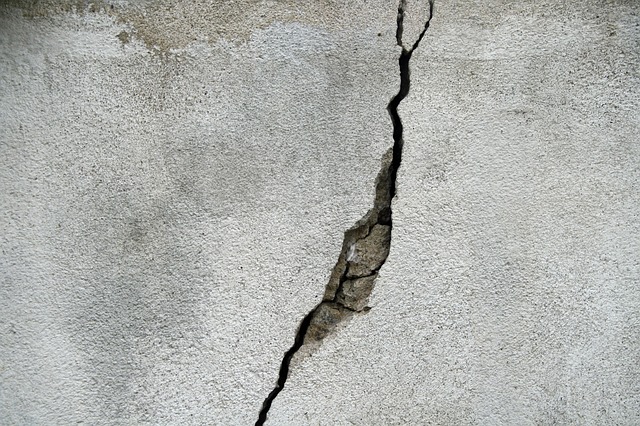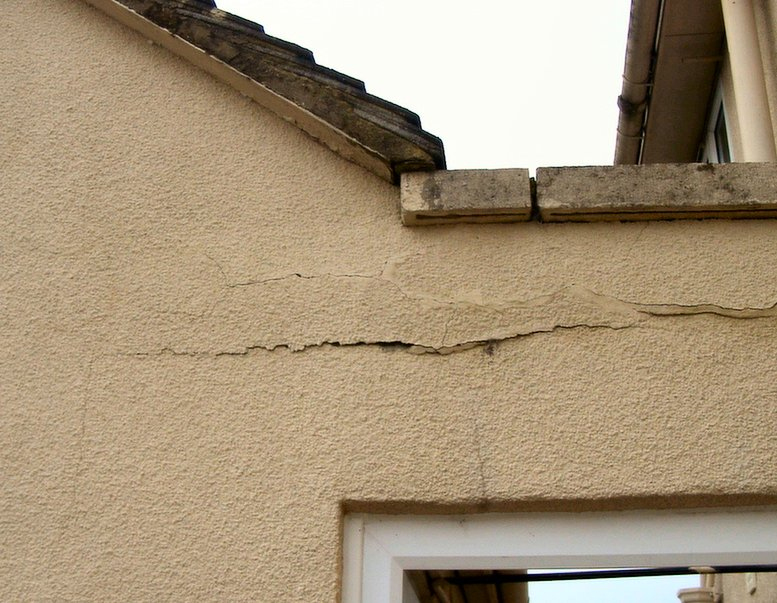Cracking and building movement
[edit] When should I be concerned about building cracks?
Buildings and other built structures are moving all the time, but usually these movements are so small as to be unnoticeable. This movement can be caused by defects, changes in ground conditions, foundation settlement, changes in the building fabric, and so on. However, if the building is unable to accommodate this movement, cracking is likely to occur. The appearance of cracks and other distortions caused by building movement can be visually unattractive and disconcerting for occupants, and if left untreated they can affect the integrity, safety and stability of the structure.
Effective treatment requires first that the causes of the cracking are understood. Only then can a strategy be developed for repairing the problem.
[edit] What are the most common causes of cracks in buildings?
The most common causes of cracks in buildings are:
- Ground movement caused by clay shrinkage, land slip, vibration, subsidence, settlement, heave, sway, and so on.
- Foundation failure due to the decay of soft clay brick, concrete erosion due to chemical contaminants, and so on.
- Decay of the building fabric, due to woodworm, rust, wet rot, dry rot and so on.
- Moisture movement that causes materials to expand or contract. Excess water, and water penetration can be caused by the presence of vegetation, faulty or damaged drains, flooding, damage to the building fabric, condensation and so on.
- Thermal movement that causes materials to expand or contract as temperature increases or decreases.
- Inherent defects, particularly in historic structures.
- Deformation under excess load.
- Tree root growth.
- The absence of foundations in older buildings.
- Alteration works to the building or neighbouring properties (Note, occupants may see cracks that have been there for some time, but are only noticed when works are taking place).
[edit] What size of cracks in buildings are significant?
BRE assessed a number of properties as part of a study that was published as BRE Digest 251 Assessment of damage in low-rise buildings. This identified six categories of cracks together with the typical damage caused and the remedy required:
- 0 - Hairline cracks: Less than 0.1 mm in width. No repair action required.
- 1 - Fine cracks: Up to 1 mm in width. Generally restricted to internal wall finishes. Easily treated using normal decoration.
- 2 - Cracks easily filled: Up to 5 mm in width. Not necessarily visible externally, but doors and windows may require adjusting to prevent sticking. Can be masked by suitable linings.
- 3 - Cracks that require opening up: Widths of 5-15 mm. Weather-tightness and service pipes may be affected. External brickwork may need repointing or, in some cases, to be replaced.
- 4 - Extensive damage: Widths of 15-25 mm. Windows and door frames become distorted, walls lean or bulge noticeably. Requires breaking-out and replacement of wall sections.
- 5 – Structural damage: Widths greater than 25 mm. Beams lose their bearing, walls require shoring, and the structure is generally unstable. May require major repair works.
[edit] What do the shapes of cracks in buildings mean?
The shape and orientation of cracks can be an indicator of the cause and seriousness of the problem:
- Hairline cracks are common in many buildings, particularly in plaster, which is prone to shrink and is very sensitive to movement, particularly if the supporting structure is old, or timber frame. The timber frame will move over time, but the plaster will not - and so it cracks.
- Stepped cracks tend to follow the lines of horizontal and vertical joints in buildings, such as beds of mortar between bricks or blocks and may indicate structural movement.
- Vertical cracks may indicate that structural components such as bricks or blocks have failed and so can be a sign of significant stresses within the building structure.
- Cracks that are wider at the top or at the bottom may indicate that there has been foundation movement, with the direction of the widening giving an indication of the likely direction of the movement.
- Horizontal cracks may indicate that an element such as a wall is failing and this may present a safety concern.
[edit] How to repair cracks in buildings
Designers of new buildings will try to ‘design out’ many of the causes that may lead to cracking by careful design of the foundations and superstructure, introducing movement joints, specifying materials that can tolerate movement, and so on. However, some cracking is still possible, particularly in buildings that are newly complete.
If cracking occurs in buildings, they should first be examined for the likely cause of movement, and assessed to determine whether this is due to an external factor such as subsidence, or is caused by the fabric of the building itself. It is important to establish whether the cracking static, or whether it is likely to be progressive and to deteriorate further, and if so, to what extent and over what period of time. Research of archival information, such as previous surveys or photos, can help with this assessment.
Repair strategies can range from limited cosmetic works to major interventions, however, unless the underlying cause has been dealt with, it is likely that further remedial work will be required in the future. Movement caused for example by vibration or by thermal expansion and contraction is likely to persist. In this case, repair materials must be chosen carefully; those with the ability to deform in a plastic manner will be more successful than those that simply increase strain around the crack and so are likely to cause the repair to fail. For example, hydraulic or fat limes may provide enough plasticity to accommodate strain. Corrosion-resistant stainless steel reinforcements can be inserted into bed joints to reduce the risk of failure by redistributing strain and stress over a wider area.
Instruments such as boroscopes can be used to locate voids that may have opened up as a result of movement. Grouting voids to fill them with cementitious material can provide a solution if the underlying cause has been dealt with.
Where underpinning of foundations is required, a number of alternative techniques are available. See underpinning for more information.
Rather than simply covering up problems, it is important to understand the reason that cracks have occurred, particularly if they are large, or if they are increasing in size, and it may be wise to seek expert advice, particularly if there might be implications for structural integrity or safety.
[edit] Related articles on Designing Buildings
- Burland scale.
- Cracking in buildings.
- Cyclic stress.
- Defects in brickwork.
- Defects in construction.
- Defects in stonework.
- Ground heave.
- Latent defects.
- Leaning Tower of Pisa.
- Movement joint.
- Preventing wall collapse.
- Pyrite and mica redress issues in Dail Eireann.
- Settlement.
- Sinkholes.
- Subsidence.
- Underpinning.
- Why do buildings crack? (DG 361).
[edit] External references
Featured articles and news
Professional practical experience for Architects in training
The long process to transform the nature of education and professional practical experience in the Architecture profession following recent reports.
A people-first approach to retrofit
Moving away from the destructive paradigm of fabric-first.
International Electrician Day, 10 June 2025
Celebrating the role of electrical engineers from André-Marie Amperè, today and for the future.
New guide for clients launched at Houses of Parliament
'There has never been a more important time for clients to step up and ...ask the right questions'
The impact of recycled slate tiles
Innovation across the decades.
EPC changes for existing buildings
Changes and their context as the new RdSAP methodology comes into use from 15 June.
Skills England publishes Sector skills needs assessments
Priority areas relating to the built environment highlighted and described in brief.
BSRIA HVAC Market Watch - May 2025 Edition
Heat Pump Market Outlook: Policy, Performance & Refrigerant Trends for 2025–2028.
Committing to EDI in construction with CIOB
Built Environment professional bodies deepen commitment to EDI with two new signatories: CIAT and CICES.
Government Grenfell progress report at a glance
Line by line recomendation overview, with links to more details.
An engaging and lively review of his professional life.
Sustainable heating for listed buildings
A problem that needs to be approached intelligently.
50th Golden anniversary ECA Edmundson apprentice award
Deadline for entries has been extended to Friday 27 June, so don't miss out!
CIAT at the London Festival of Architecture
Designing for Everyone: Breaking Barriers in Inclusive Architecture.
Mixed reactions to apprenticeship and skills reform 2025
A 'welcome shift' for some and a 'backwards step' for others.
























Comments
To make a comment about this article, click 'Add a comment' above.
Separate your comments from any existing comments by inserting a horizontal line.
who is the author for this article?
Designing Buildings is an open access wiki site. Articles are written collaboratively by the users of the site and as such there is no singe, identifiable author.
Some cracking seems impossible to prevent. Rigid plaster on a timber lath wall is always going to crack. Papering covers it up but doesnt really fix it.